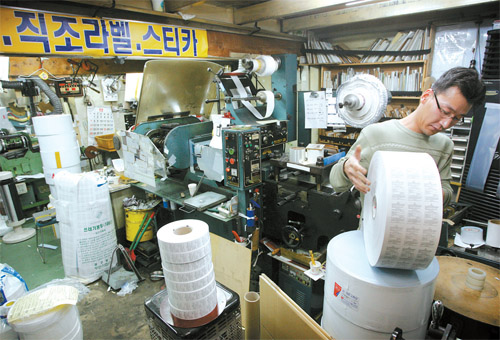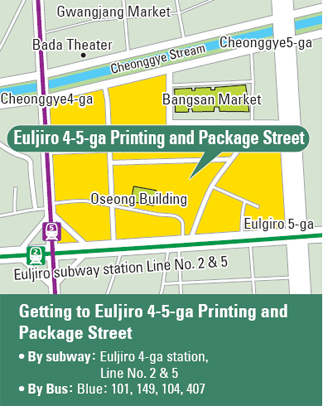Cookies helped create street known for printing

A printing shop employee works on a roll of labels in Euljiro 4-5-ga Printing and Package Street in central Seoul. By Oh Samg-min
“There are some shops that do make calendars and cards here, but profit margins are small,” said Kang Tae-yoon, who runs Dongchang Industrial, a polyvinyl chloride packaging company, and is a top member of the local market association. “Most publication-related printing companies have moved to the outskirts, like Paju Book City.”
“Printing companies industrialized and grew in scale. They needed more room for printing presses,” Kang added.
He also said fewer people are buying calendars today, while many young people use the Internet to purchase Christmas and New Year’s greeting cards.

But that, too, has changed.
The street hasn’t been printing such posters since the late 1980s when the country was under the militant rule of then-President Chun Doo-hwan.
“Political camps started to hire bigger ad agencies when promoting their campaigns,” said Kang. “Things started to change and we haven’t seen any political poster making on this street for a decade or more.
To stay alive, the street has had to specialize and evolve.
The Euljiro 4-5-ga printing and packaging street, where 3,000 companies have settled, is located in the lower area of Bangsan Market and across the street from Jungbu Market, Jung District.
Nobody seems to know exactly when the market was established, but it’s widely believed that it began taking shape sometime during the Japanese colonial period. But at that time, it didn’t emphasize printing and packaging. Pre-Korean War print shops were mostly located around Namdaemun and neighboring Mugyo-dong. They moved north and settled in Euljiro in the late 1960s.
They developed hand-in-hand with shops producing candies and bakery goods, since those shops needed printing and packaging.
Merchants started to sell baking goods smuggled out of the nearby U.S. Army base.
Even today in the upper part of the Bangsan Market there are lines of stores selling cookie cutters.
Surrounding those bakery utensil shops are small stores selling various boxes for packaging cookies and cakes.
Some of the sidewalks of the main street are piled high with boxes.
However, the smaller alleys behind the main street contain small factories that print a wide variety of products, including business cards. Some of the shops are so small that barely two people can be seated comfortably. A printing press takes up most of the space.
When walking down the street, one can feel vibrations from the rumbling machines.
Since 2003, the street has held a printing culture festival every year in October.
That printing culture in this neighborhood has also changed from the simple printing of publications to specialized printing, including lettering on boxes.
“For survival, the factories here started to create their own unique printing that specializes on various goods, including the customized printing on mobile phones, accessory goods and even business cards,” said Kang.
“Many of the stores here use their own specialized techniques that do not require a lot of space,” he added.
Although there are some retail sales, most of the businesses in Euljiro 4-5-ga are wholesalers.
The market flourished in 1986 when Korea hosted the Asian Games and in 1988 when Korea hosted the Olympics.
But everything slowed in the late 1990s.
“The only time of the year that was not busy season was in July and August, which is the vacation season,” said a store owner who requested anonymity.
“Around February and March our printers start rolling because schools start and people want a lot of packaging of text books,” the owner said.
“It’s very much the same in late August and September.”
Especially for houses specializing in packaging, the two biggest national holidays - Lunar New Year’s and Chuseok, Korea’s thanksgiving - really churn out business.
However, business in recent months hasn’t been as good as in the past due to the frozen economy and the fierce competition on the internet.
“It’s hard to charge more than what we do because customers research the prices on the Internet before visiting here,” another store owner said.
“The Internet is a fast growing industry and it’s very competitive, which makes business a bit more challenging,” he added.
The owner said, however, that doesn’t necessarily mean business has been bad. Some of the small factories still run late into the night when other stores have turned off the lights and closed the shutters.
The printing and packaging market is planning to make changes to meet modern tastes.
Not only are the store owners planning to upgrade outdated buildings to accommodate larger printing and packaging equipment, but they are also making way for more parking.
“I say the people working here are rich not because they have piled up gold, but because they have their own unique techniques and contributed their youth to enhancing Korea’s printing business,” said Kang.
By Lee Ho-jeong Staff Reporter [ojlee82@joongang.co.kr]










with the Korea JoongAng Daily
To write comments, please log in to one of the accounts.
Standards Board Policy (0/250자)